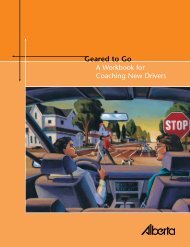Commercial driver's guide to operation, safety and licensing
Commercial driver's guide to operation, safety and licensing
Commercial driver's guide to operation, safety and licensing
Create successful ePaper yourself
Turn your PDF publications into a flip-book with our unique Google optimized e-Paper software.
Fueling a vehicle<br />
Gasoline <strong>and</strong> diesel<br />
• Do not add fuel in<strong>to</strong> the tank when the<br />
engine is running.<br />
• Never overfill the fuel tank.<br />
• In the event of a major or minor fuel<br />
spill, notify the attendant <strong>to</strong> get it<br />
cleaned up immediately using an<br />
approved absorbent material.<br />
• Do not add fuel close <strong>to</strong> electrical<br />
sparks or open flame.<br />
• DO NOT SMOKE, <strong>and</strong> be sure no one<br />
around is smoking.<br />
• Do not use a cell phone while fueling.<br />
Propane<br />
• Only people with the proper certification<br />
or training can refuel a propane vehicle<br />
or container.<br />
• Ensure there is nothing that could ignite<br />
within three metres (10 feet) of the<br />
dispenser or container being filled.<br />
• Wear proper protective gloves <strong>and</strong><br />
clothing, such as long sleeve shirts.<br />
• Engine <strong>and</strong> electrical accessories must<br />
be switched off.<br />
• DO NOT SMOKE, <strong>and</strong> be sure no one<br />
around is smoking.<br />
• Do not use a cell phone while fueling.<br />
• Properly attach the filling hose <strong>to</strong> the<br />
vehicle’s fuel tank.<br />
• Open the fixed-liquid level gauge<br />
(bleeder valve).<br />
• When the fuel level reaches the<br />
maximum permitted in the tank, liquid<br />
propane in the form of a mist will be<br />
discharged from the liquid level gauge.<br />
Fueling should now end.<br />
• The fixed level gauge must be shut off<br />
<strong>and</strong> the fill-line disconnected.<br />
• The magnetic float gauge attached <strong>to</strong><br />
the tank should indicate that the tank is<br />
now filled <strong>to</strong> capacity. The <strong>to</strong>tal capacity<br />
of the tank is approximately 80 percent.<br />
Do not fuel a vehicle when the engine<br />
is running or a radio transmitter is on.<br />
Vehicles such as a bus, school bus or taxi<br />
should not be fueled when passengers are<br />
on board. Be sure there is sufficient fuel for<br />
the trip before picking up your passengers.<br />
Fuel efficiency:<br />
A growing priority<br />
The following information has been<br />
provided by Natural Resources Canada<br />
in conjunction with the Government<br />
of Alberta <strong>to</strong> introduce energyefficient<br />
practices that can reduce fuel<br />
consumption <strong>and</strong> emissions. FleetSmart<br />
is a component of this program. For more<br />
information on this subject visit this web<br />
site: http://www.transportation.alberta.<br />
ca/4531.htm<br />
As fuel prices fluctuate, independent<br />
drivers <strong>and</strong> major transport companies<br />
are struggling <strong>to</strong> accurately budget for fuel<br />
costs <strong>and</strong> are actively searching for ways<br />
<strong>to</strong> keep those costs under control.<br />
90 A <strong>Commercial</strong> Driver’s Guide <strong>to</strong> Operation, Safety <strong>and</strong> Licensing




